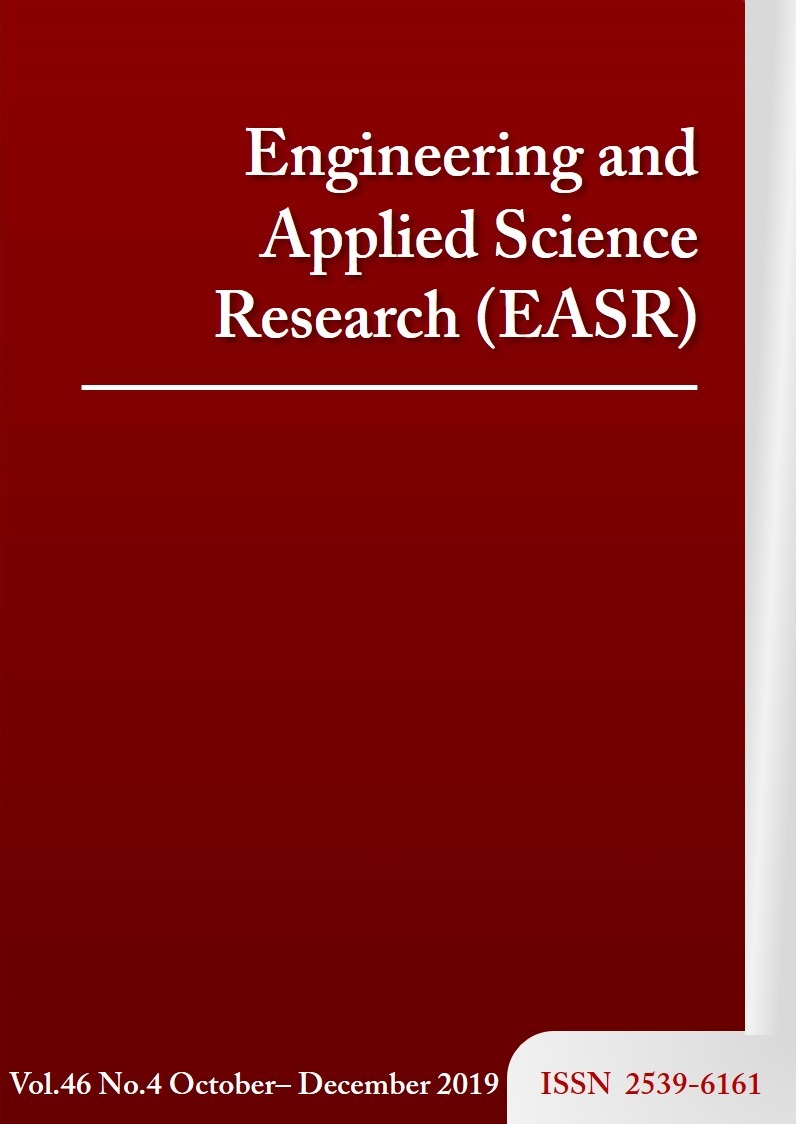Water vapor barrier property of PLA nanocomposites using rice husk ash and layered double hydroxides as fillers
Main Article Content
Abstract
Biodegradable polylactic acid (PLA) nanocomposite films with organically modified nanoclay (PKL_DS) and silica from rice husk ash (SiRHA) incorporation were prepared using a solvent casting method. The morphology and water vapor transmission rate behavior of these PLA based nanocomposite films with the addition of PKL_DS and SiRHA fillers was investigated at various loadings. The morphology of the nanocomposite was examined using X-ray diffraction (XRD), transmission electron microscopy (TEM) and scanning electron microscopy (SEM). It was confirmed that PLA molecular chains were intercalated into the interlayers of nanoclay (PKL_DS), which was well dispersed in the PLA matrix. TEM results showed SiRHA agglomerates and poor dispersion. The scanning electron microscopy (SEM) results showed good dispersion and good compatibility between nanoclay (PKL_DS) and the PLA matrix, while the SiRHA filler exhibited phase separation, silica agglomeration and some pore structures in the PLA matrix. The surface of the nanocomposite film with the incorporation of a SiRHA/PKL_DS combination exhibited a dense structure. A maximum reduction of 67% of water vapor transmission rate (WVTR) was obtained for nanocomposite films with co-addition of 10 wt% PKL_DS and 3 wt% SiRHA over that of PLA alone. It is concluded that the incorporation of a SiRHA/PKL_DS combination was very effective in improving the water vapor barrier property of a PLA based nanocomposite.
Article Details
This work is licensed under a Creative Commons Attribution-NonCommercial-NoDerivatives 4.0 International License.
References
Bugatti V, Livi S, Hayrapetyan S, Wang Y, Estevez L, Vittoria V, et al. Deposition of LDH on plasma treated polylactic acid to reduce water permeability. J Colloid Interface Sci. 2013;396:47-52.
Shankar S, Wang LF, Rhim JW. Incorporation of zinc oxide nanoparticles improved the mechanical, water vapor barrier, UV-light barrier, and antibacterial properties of PLA-based nanocomposite films. Mater Sci Eng C. 2018;93:289-98.
Pilić BM, Radusin TI, Ristić IS, Silvestre C, Lazić VL, Baloš SS, et al. Silica nanoparticles as reinforcing filler for poly (lactic acid) matrix. Hem Ind. 2016;70:73-80.
Masnar A, Coorey R. Application of sago pith waste and nanosilica from rice husk ash as hybrid bio-nanofiller composites for food plastic packaging. Ukr Food J. 2017;6:618-31.
Opaprakasit P, Boonpa S, Jaikaew N, Petchsuk A, Tangboriboonrat P. Preparation of surface-modified silica particles from rice husk ash and its composites with degradable polylactic acid. Macromol Symp. 2015;354:48-54.
Duan Z, Thomas NL, Huang W. Water vapour permeability of poly(lactic acid). J Membrane Sci. 2013;445:112-8.
Rhim JW, Hong SI, Ha CS. Tensile, water vapor barrier and antimicrobial properties of PLA/nanoclay composite films. LWT-Food Sci Techno. 2009;42:612-7.
Pantani R, Gorrasi G, Vigliotta G, Murariu M, Dubois P. PLA-ZnO nanocomposite films: vapor barrier properties and specific end-use characteristics. Eur Polym J. 2013;49:3471-82.
Tan B, Thomas NL. Tortuosity model to predict the combined effects of crystallinity and nano-sized clay mineral on the water vapour barrier properties of polylactic acid. Appl Clay Sci. 2017;141:46-54.
Zenkiewicz M, Richert J. Permeability of polylactide nanocomposite films for water vapour, oxygen and carbon dioxide. Polym Test. 2008;27:835-40.
Thellen C, Orroth C, Froio D, Ziegler D, Lucciarini J, Farrell R, et al. Influence of montmorillonite layered silicate on plasticized poly (L-lactide) blown films. Polymer. 2005;46:11716-27.
Shogren R. Water vapor permeability of biodegradable polymers. J Environ Polym Degrad. 1997;5:91-5.
Nielsen LE. Models for the permeability of filled polymer systems. J Macromol Sci Pure Appl Chem. 1967;5:929-42.
Shabanian M, Basaki N, Khonakdar HA, Jafari SH, Hedayati K, Wagenknecht U. Novel nanocomposites consisting of a semi-crystalline polyamide and Mg-Al LDH: morphology, thermal properties and flame retardancy. Appl Clay Sci. 2014;90:101-8.
Athinarayanan J, Periasamy VS, Alhazmi M, Alatiah K.A, Alshatwi AA. Synthesis of silica nanoparticles from rice husks for biomedical applications. Ceram Int. 2015;41:275-81.
Sankar S, Sharma SK, Kaur N, Lee B, Kim DY, Lee S, et al. Biogenerated silica synthesized from sticky, red, and brown rice husk ashes by a chemical method. Ceram Int. 2016;42:4875-85.
Livi S, Bugatti V, Estevez L, Rumeau JD, Giannelis EP. Synthesis and physical properties of new layered double hydroxides based on ionic liquids: Application to a polylactide matrix. J Colloid Interface Sci. 2012;388:123-9.
Pan P, Zhu B, Dong T, Inoue Y. Poly(L-lactide)/layered double hydroxides nanocomposites: preparation and crystallization behavior. J Polym Sci B. 2008;46:2222-33.
Alamri H, Low IM, Alothman Z. Mechanical, thermal and microstructural Characteristics of cellulose fibre reinforced epoxy/organoclay nanocomposites. Composites Part B. 2012;43:2762-71.
Fang G, Li H, Chen Z, Liu X. Preparation and properties of palmitic acid/SiO2 composites with flame retardant as thermal energy storage materials. Sol Energy Mater Sol Cells. 2011;95:1875-81.
Elbasuney S. Surface engineering of layered double hydroxide (LDH) nanoparticles for polymer flame retardancy. Powder Technol. 2015;277:63-73.
Chiang MF, Wu TM. Synthesis and characterization of biodegradable poly(L-lactide)/layered double hydroxide nanocomposites. Compos Sci Technol. 2010;70:110-5.
Chiang MF, Wu TM. Preparation and characterization of melt processed poly(L-)/layered double hydroxide nonocomposites. Composites Part B. 2012;43:2789-94.
Basu D, Das A, Stockelhuber KW, Wagenknecht U, Heinrich G. Advances in layered double hydroxide (LDH) - based elastomer composites. Prog Polym Sci. 2014;39:594-626.
Daramola OO, Oladele IO, Adewuyi BO, Sadiku R, Agwuncha SC. Thermal, structure and morphological properties of high density polyethylene matrix composites reinforced with submicron agro silica particles and titania particles. J Taibah Uni Sci. 2017;11(4):645-53.



